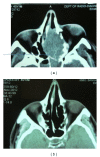Paranasal sinus neuroendocrine carcinoma: a case report and review of the literature
- PMID: 23476846
- PMCID: PMC3586447
- DOI: 10.1155/2013/728479
Paranasal sinus neuroendocrine carcinoma: a case report and review of the literature
Abstract
Neuroendocrine neoplasms are defined as epithelial neoplasms with predominant neuroendocrine differentiation. They can arise in almost every organ of the body although they are most commonly found in the gastrointestinal tract and respiratory system. Nasal cavity and paranasal sinuses are a rare site for neuroendocrine carcinoma. In contrast to the other regions, neuroendocrine tumours of the sinuses have been reported to be recurrent and locally destructive. Very few cases of paranasal sinus neuroendocrine carcinoma have been reported till date. Difficulty in pathologic diagnosis and rarity of this malignancy have hindered the progress in understanding the clinical course and improving outcomes. We herein report a case of poorly differentiated neuroendocrine tumour of ethmoid and sphenoid sinus with invasion of orbit and intracranial extension. The patient had complete response at the end of chemoradiation and he was disease-free for 9 months duration after which he developed bone metastasis without regional recurrence.
Figures




References
-
- Osguthorpe JD. Sinus neoplasia. Archives of Otolaryngology. 1994;120(1):19–25. - PubMed
-
- Raychowdhuri RN. Oat cell carcinoma and paranasal sinuses. The Journal of Laryngology & Otology. 1965;79(3):253–255. - PubMed
-
- Tarozzi M, Demarosi F, Lodi G, Sardella A, Carrassi A. Primary small cell carcinoma of the nasal cavity with an unusual oral manifestation. Journal of Oral Pathology and Medicine. 2007;36(4):252–254. - PubMed
-
- Mitchell EH, Diaz A, Yilmaz T, et al. Multimodality treatment for sinonasal neuroendocrine carcinoma. Head & Neck. 2012;10:1372–1376. - PubMed
-
- Silva EG, Butler JJ, Mackay B, Goepfert H. Neuroblastomas and neuroendocrine carcinomas of the nasal cavity: a proposed new classification. Cancer. 1982;50(11):2388–2405. - PubMed
LinkOut - more resources
Full Text Sources
Other Literature Sources

